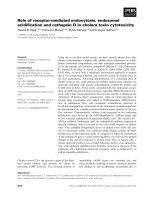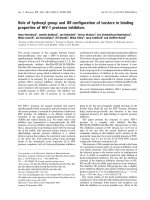Báo cáo khoa học: " Role of iron in anaemic critically ill patients: it’s time to investigate" pps
Bạn đang xem bản rút gọn của tài liệu. Xem và tải ngay bản đầy đủ của tài liệu tại đây (34.72 KB, 2 trang )
306
EPO = erythropoietin; ICU = intensive care unit; IL = interleukin; IRP = iron regulatory protein; RBC = red blood cell.
Critical Care October 2004 Vol 8 No 5 Piagnerelli and Vincent
Anaemia is a major cause of morbidity and mortality
worldwide and is often observed in critically ill patients, not
just at admission but particularly during intensive care unit
(ICU) stay [1]. The time course of anaemia during an ICU
stay depends on the underlying pathologies [1], but at least a
third of ICU patients receive a transfusion at some point
during their ICU stay [2,3]. The rationale behind blood
transfusion is to restore oxygen delivery and provide a
reserve should further bleeding occur. Several recent studies
have modified transfusion practice, in terms of the level of
pretransfusion haemoglobin concentration [3] and in view of
the adverse effects of blood transfusion, including
haemodynamic and immunomodulatory effects, and
transmission of micro-organisms [2,3].
The aetiology of anaemia is often multifactorial, including
overt or occult blood loss (e.g. resulting from frequent blood
sampling or surgical procedures), haemodilution, reduced
red blood cell (RBC) production caused by decreased
synthesis of endogenous erythropoietin (EPO), and probably
also reduced RBC lifespan due to increased uptake by the
reticuloendothelial system [4,5]. Alteration in iron metabolism
plays a central role in the development of anaemia [6]. The
majority of the body’s iron content is incorporated into
haemoglobin in developing erythroid precursors and mature
RBCs, but this process is rapidly altered with the acute
phase reaction. Typically, the inflammatory process is
associated with low concentrations of serum iron, high ferritin
(the protein responsible for iron storage), and low transferrin
(the principal iron transporting glycoprotein) [7]. The
underlying mechanisms are very complex and not well
understood, although the final teleological aim is primarily to
deprive bacteria of nutritionally required iron. In fact, in just a
few hours, proinflammatory and anti-inflammatory cytokines
cause a decrease in the iron level in blood.
Proinflammatory cytokines such as tumour necrosis factor-α,
IL-1β and IL-6 induce the transcription and the translation of
ferritin; modulate the binding affinity of cytoplasmic iron
regulatory protein (IRP)-1 and IRP-2, which contain iron-
responsive elements; and rapidly decrease the mRNA
expression of transferrin receptor [8]. Interferon-γ stimulates
Commentary
Role of iron in anaemic critically ill patients: it’s time to
investigate!
Michael Piagnerelli
1
and Jean-Louis Vincent
2
1
Resident, Department of Intensive Care, Erasme Hospital, Free University of Brussels, Brussels, Belgium
2
Head, Department of Intensive Care, Erasme Hospital, Free University of Brussels, Brussels, Belgium
Corresponding author: Michael Piagnerelli,
Published online: 3 June 2004 Critical Care 2004, 8:306-307 (DOI 10.1186/cc2884)
This article is online at />© 2004 BioMed Central Ltd
See Review, page 356
Abstract
Anaemia is a common problem in critically ill patients admitted to intensive care units. Many factors
can be involved in its development, including rapid alterations in iron metabolism. Maintenance of iron
homeostasis is a prerequisite for many essential biological processes and is a central element for the
development of erythroid precursors and mature red blood cells. With the inflammatory process, iron
distribution is disturbed, with decreased serum iron levels and increased iron stores. Little information
is available on the precise role of alterations in iron metabolism in the development of iron anaemia in
critically ill patients.
Keywords anaemia, erythropoietin, iron, red blood cell
307
Available online />iron absorption by enterocytes via the divalent metal
transporter-1, but it has an inhibitory effect on ferroprotein –
another enterocyte protein that transfers oxidized iron into the
circulation. These alterations result in increased iron storage
in enterocytes [9]. Anti-inflammatory cytokines such as IL-4,
IL-10 and IL-13 induce haem oxygenase-1 expression to
promote haem degradation and iron storage in monocytes
and thereby contribute to iron storage in the reticulo-
endothelial system [10]. Nitric oxide reduces RBC
production by stimulating IRP and reducing ferrochelatase
activity, which inhibits the final step in heme synthesis [11].
In the present issue of Critical Care, Darveau and coworkers
[12] review the literature on iron supplementation in anaemic
critically ill patients. That article reveals the lack of studies
evaluating alterations in iron metabolism in ICU patients.
Darveau and coworkers [12] also provide a summary of
studies using EPO therapy, the rationale behind this strategy
in anaemic ICU patients being that EPO levels are
inappropriately low [6] as a result of the effects of
proinflammatory cytokines (interferon-γ, tumour necrosis
factor-α, IL-1) that inhibit EPO receptors on erythroid
progenitor cells. In randomized, double-bind, placebo-
controlled studies, Corwin and coworkers [13,14]
demonstrated the safety of EPO treatment plus iron
administration and the resulting decrease in number of RBC
transfusions needed, but regrettably they reported no effects
on outcome in terms of ICU infection rates or mortality. Only
one study [15] compared the effect of iron administration
(20 mg/day intravenously) with that of treatment with EPO
(300 mg subcutaneously on days 1, 3, 5, 7 and 9) and iron.
Surprisingly, in that study the reticulocyte count increased
significantly at day 6 in the EPO-treated group as compared
with the iron and control groups, but it rapidly decreased
thereafter, with no apparent difference between groups at
day 18. Moreover, there were no differences in ICU length of
stay or the total number of RBC transfusions after 3 weeks
between the iron and EPO groups. Although the number of
patients was limited, this is probably the only study
comparing iron administration and EPO therapy in the ICU.
Importantly, both treatments have possible side effects: for
EPO treatment, anti-EPO antibodies with severe aplasia [16],
transient alterations in RBC rheology [17] and anaemia
secondary to cessation of intensive treatment [18]; and for
iron administration, anaphylactoid reactions with increased
risk for infection [7].
As highlighted by Darveau and coworkers [12], before
supplementing critically ill patients with iron we need
additional studies to investigate and better define the role
played by iron, including the place of primordial regulators of
iron metabolism such as hepcidin and transferrin receptor
[19,20], in the development of anaemia in this population.
Competing interests
The authors declare that they have no competing interests.
References
1. Nguyen Ba V, Peres Bota D, Melot C, Vincent JL: Time course of
hemoglobin concentrations in non-bleeding ICU patients. Crit
Care Med 2003, 31:406-410.
2. Vincent JL, Baron JF, Reinhart K, Gattinoni L, Thijs L, Webb A,
Meier-Hellmann A, Nollet G, Peres-Bota D: Anemia and blood
transfusion in critically ill patients. JAMA 2002, 288:1499-1507.
3. Hebert PC, Wells G, Blajchman MA, Marshall J, Martin C,
Pagliarello G, Tweeddale M, Schweitzer I, Yetisir E: A multicen-
ter, randomized, controlled clinical trial of transfusion require-
ments in critical care. N Engl J Med 1999, 340:409-417.
4. Piagnerelli M, Boudjeltia KZ, Vanhaeverbeek M, Vincent JL: Red
blood cell rheology in sepsis. Intensive Care Med 2003, 29:
1052-1061.
5. Piagnerelli M, Zouaoui Boudjeltia K, Brohee D, Piro P, Carlier E,
Vincent JL, Lejeune P: Alterations of red blood cell shape and
sialic acid membrane content in septic patients. Crit Care Med
2003, 31:1052-1061.
6. Rogiers P, Zhang H, Leeman M, Nagler J, Neels H, Mélot C,
Vincent JL: Erythropoietin response is blunted in critically ill
patients. Intensive Care Med 1997, 23:159-162.
7. Patruta SI, Horl WH: Iron and infection. Kidney Int Suppl 1999,
69:S125-S130.
8. Rogers JT: Ferritin translation by interleukin-1and interleukin-
6: the role of sequences upstream of the start codons of the
heavy and light subunit genes. Blood 1996, 87:2525-2537.
9. Ludwiczek S, Aigner E, Theurl I, Weiss G: Cytokine-mediated
regulation of iron transport in human monocytic cells. Blood
2003, 101:4148-4154.
10. Lee TS, Chau LY: Heme oxygenase-1 mediates the anti-
inflammatory effect of interleukin-10 in mice. Nat Med 2002, 8:
240-246.
11. Rafferty SP, Domachowske JB, Malech HL: Inhibition of hemo-
globin expression by heterologous production of nitric oxide
synthase in the K562 erythroleukemic cell line. Blood 1996,
88:1070-1078.
12. Darveau M, Denault AY, Blais N, Notebaert E: Bench-to-bedside
review: Iron metabolism in critically ill patients. Crit Care
2004, 8:356-362.
13. Corwin HL, Gettinger A, Rodriguez RM, Pearl RG, Gubler KD,
Enny C, Colton T, Corwin MJ: Efficacy of recombinant human
erythropoietin in the critically ill patient: a randomized,
double-blind, placebo-controlled trial. Crit Care Med 1999, 27:
2346-2350.
14. Corwin HL, Gettinger A, Pearl RG, Fink MP, Levy MM, Shapiro
MJ, Corwin MJ, Colton T: Efficacy of recombinant human ery-
thropoietin in critically ill patients: a randomized controlled
trial. JAMA 2002, 288:2827-2835.
15. van Iperen CE, Gaillard CA, Kraaijenhagen RJ, Braam BG, Marx
JJ, van de Wiel A: Response of erythropoiesis and iron metab-
olism to recombinant human erythropoietin in intensive care
unit patients. Crit Care Med 2000, 28:2773-2778.
16. Casadevall N, Nataf J, Viron B, Kolta A, Kiladjian JJ, Martin-Dupont
P, Michaud P, Papo T, Ugo V, Teyssandier I, Varet B, Mayeux P:
Pure red-cell aplasia and antierythropoietin antibodies in
patients treated with recombinant erythropoietin. N Engl J
Med 2002, 346:469-475.
17. Bor-Kucukatay M, Yalcin O, Meiselman HJ, Baskurt OK: Erythro-
poietin-induced rheological changes of rat erythrocytes. Br J
Haematol 2000, 110:82-88.
18. Piron M, Loo M, Gothot A, Tassin F, Fillet G, Beguin Y: Cessation
of intensive treatment with recombinant human erythropoietin
is followed by secondary anemia. Blood 2001, 97:442-448.
19. Ganz T: Hepcidin, a key regulator of iron metabolism and
mediator of anemia of inflammation. Blood 2003, 102:783-
788.
20. Fillet G, Beguin Y: Monitoring of erythropoiesis by the serum
transferrin receptor and erythropoietin. Acta Clin Belg 2001,
56:146-154.









